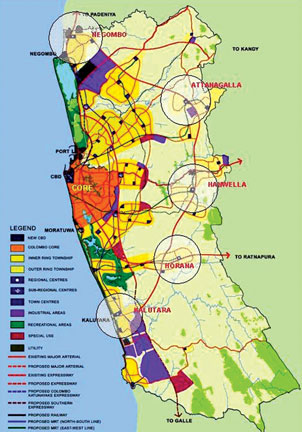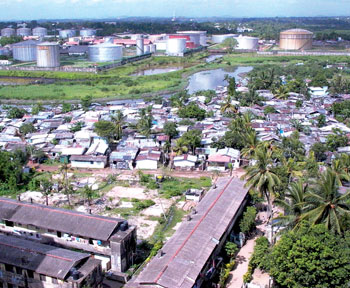|
Point of view:
Role of town planners in urban development
by M. T. O. V. Peiris and R. S. U. Kumara
The discipline of town and country planning has a broad set of
activities focused on practical planning. The planner identifies and
solves problems of urban and rural land use development,
industrialisation, energy, transportation, telecommunication, shelter
and growth through devolution of power to sub national levels. The
planner integrates all these factors to create a sound land use system.
 Town and country planning is not new to Sri Lanka. Historical
perspectives of ancient Sri Lankan city planning give classic examples
of better town planning. Starting with the early Anuradhapura kingdom in
the third century BC, it had unique fortresses, palaces, pagodas and
reservoirs. Sigiriya is one of the marvellous creations of planning. We
have evidence to prove that before the introduction of modern town
planning to Sri Lanka by the British, our ancestors had deep and
efficient knowledge on city planning with land use compatibility. Town and country planning is not new to Sri Lanka. Historical
perspectives of ancient Sri Lankan city planning give classic examples
of better town planning. Starting with the early Anuradhapura kingdom in
the third century BC, it had unique fortresses, palaces, pagodas and
reservoirs. Sigiriya is one of the marvellous creations of planning. We
have evidence to prove that before the introduction of modern town
planning to Sri Lanka by the British, our ancestors had deep and
efficient knowledge on city planning with land use compatibility.
Proud historical heritage
Therefore, as Sri Lankans, we have a proud historical heritage where
it can stand for the foundation or base of town planning. As
undergraduate planning students, we have engaged in plan making
exercises together with the ground level analysis. The completion of the
degree program creates a complete and dynamic young planner who can rely
on ground level reality for resolving urban development issues in
different contexts in different times.
Urban development in Sri Lanka had several faces in different times,
and the young planner has the knowledge and rational decision-making
power which can suit any condition.
This ability differentiates the young planner with others to make
better decisions to satisfy the needs of stakeholders in any community
issue. But today in Sri Lanka, it is hardly being seen in the town
planner's activity on administration level.
There are urban development areas declared by the Urban Development
Authority (UDA). The Colombo Municipal Council has a separate section
for solving town planning issues, where as other councils do not have
any. In this context, the planner has to face multiple challenges in
between his task and arising issues of Sri Lanka. Firstly, it is
important to identify the definition of urban development, its level in
Sri Lanka, urban areas related issues and the limitations in the current
strategies, how young planner's intervention matters in these cases.
Urban development in Sri Lanka
The term 'Urban Development' comprises a wide meaning which includes
physical, socio-economic and environmental aspects in a given urban
area; but in respect of town planning a greater emphasis is laid on the
physical development of land within the urban entity. Litchfield
succinctly points out to this aspect when he says: "Physical development
has its socio-economic implications. And from the regional and national
level the growth with which that development is concerned cannot take
place without the contribution of the buildings and infrastructure
provided by physical development. Increases in productivity and output
cannot be provided without the built fabric which is to house the
machinery and labour.
"Sri Lanka is a fast developing country where urban development is a
prime requirement to achieve the development on the way to be a
developed country. With the current economic structure, a developing
country's prime focus is to achieve development through accelerated
economic growth policies where developed countries focus on the
environmental conservation and reduction of adverse consequences on
environment. Under these circumstances Sri Lanka's economy requires more
urban activities, mainly industrial and commercial based activities.
With the improvement of built infrastructure such as highways,
expressways, airports, harbours, power plants, water supply schemes and
economy-based built forms such as industrial parks, commercial
developments and economic zones.
Create urban development
The Sri Lankan context in above development trends are significant.
We can identify the urban character of many towns and higher
agglomeration of commercial and industrial activities in and around.
Also the population concentration of these major towns have exceeded
their threshold limits, so surrounded suburbs supported them with the
attraction of overspill population.
With the expansion of urban activities, Colombo Metropolitan Region
has highest spatial boundary as a region which is a classic example of
development as well as the complexity of urban form. Town planner's
rational decision-making power really matters on these situations to
guide its development towards a correct path. Hambantota harbour and
Mattala airport create more urban areas in the southern area and the
southern expressway linking Hambantota and Colombo will develop the
suburbs specially based on 11 major interchanges.
In the same way the Eastern revival and Northern area development
will create more urban centres within the next decade. Sri Lanka has a
definite trend of urbanisation and urban development all over the
country. In this situation, it can easily convert this development into
an ad hoc situation if there's no proper management of land uses through
promotional and controlling mechanism.
Urban development related issues
Urban area related issues are common to any country. Every country
faces similar problems with the achievement of developed levels. But the
continuation of the same problem shows the management issues and
negative attention on the ground level situation. Sri Lanka faces this
problem for a long time especially with the commercial capital-Colombo.
With the urbanisation trend and increase of services within the core
areas of the town create lots of congestion, pollution and many socio
economic issues. Sometimes it's less attention on the actual situation
from the ground level perspective by the officials.
However, lack of direct intervention of the young planner on the
problem solving exercise is significant in these cases. Existence of
urban issues in Sri Lanka can be analysed under two themes.
Those are the issues due to haphazard development within the urban
areas and management issues with the institutional set up. But, when we
analyse the ad hoc development in Colombo and other urban areas,the
integration of all these factors, institutional deficiency, and
loopholes in the legal system as well as the attitudinal problems of the
people can be seen. This happens with the land use changes in urban
areas.
 |
|
A section of the
Colombo city |
Spatial planning perspective explains the land use changes with the
demand on land for the highest and best use. Based on the profitability
and utility values of the people, industrial, commercial land uses are
dominated in urban localities.
Small land plot sizes, high rise development, decrease of
agricultural uses are common changes in land use activities in urban
areas.To manage this conversion of land use, the spatial planner's
intervention is necessary at the town and country level.
The problems created by this situation, unless corrective action is
taken on systematically planned basis, can be expected to manifest in
several ways such as: 1. Land encroachments into available state land
which will include in environmentally sensitive areas by causing severe
adverse effects; 2. Land encroachments in the urban periphery, which is
extending even in to available private lands; 3. Further fragmentation
of agricultural land, either by private sector developers or by the
state sectors, where necessary, to procedures by enforcements of the
Land Acquisition Act; (irrespective of appropriate urban development in
terms of plans which deal into ad hoc land development) 4. Unplanned
urban expansion (urban sprawl).
There are issues raised with the urban development in the
environment. Traffic congestion in main arteries, road accidents,
insufficient road width for increasing vehicle population, poor traffic
management systems are some problems related to road infrastructure.
Also vehicular emissions, green house gases (GHGs) create air
pollution and urban heat islands which has a heavy impact on urban
areas.
Colombo city is facing this problem and this created Colombo as the
4th worst city to stay in the international arena. High density
population is one reason for this problem.
Average population density in Sri Lanka is about 300 persons per km2,
but it's 2000 persons per sq. km in Colombo city.
This very high population density not only creates transport and
other infrastructure issues, also the socio economic problems with
health, education related problems are also significant.
The population concentration exceeded the threshold levels in
Colombo, the same as many district capitals in Sri Lanka such as Gampaha,
Kalutara, Matara, Badulla and Kandy.Rural-urban migration with more
infrastructure and services in urban centres has to be managed by
professionals and experts in the subject as town planners.
To be continued
|

